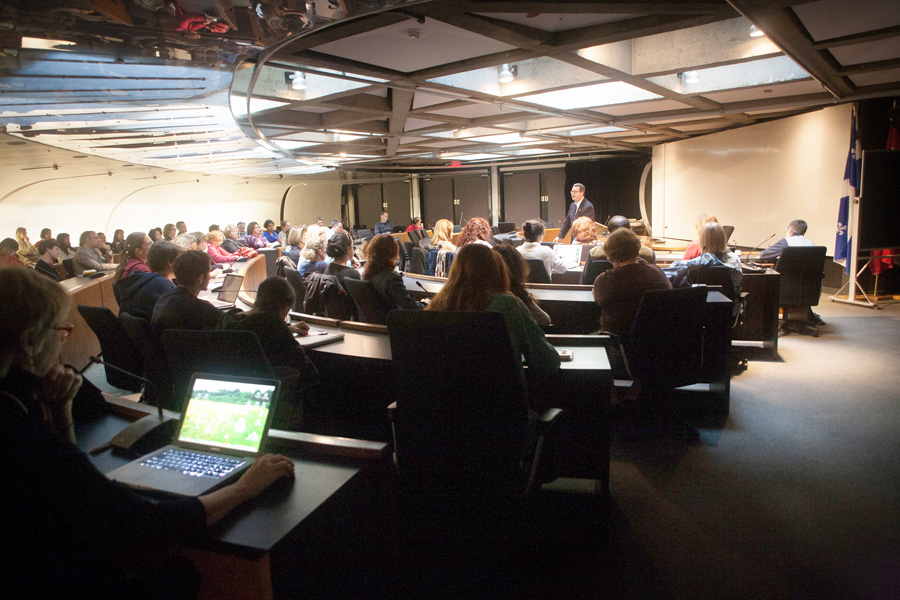Last Thursday, Dean of Arts Christopher Manfredi held a meeting to update students, faculty, and staff about the ongoing plan to restructure the use of space within the Faculty of Arts. Called People, Processes, and Partnerships (PPP), the project intends to reduce administrative inefficiencies and help the faculty deal with reduced resources stemming from budget cuts.
The space restructuring initiative was introduced last April but has undergone substantial change since then due to criticism of the project. The question and answer session was attended by over 50 McGill community members.
Currently, each department in the Faculty of Arts has its own specialized administrative staff. The original PPP floor plan proposals concerning the Leacock departments looked to consolidate administrative services along functional lines, mostly concentrated on the third floor of the Leacock building. The new version will include the creation of six “integrated service groups,” each of which will be responsible for one or more of the faculty’s 16 departments.
Some of the project’s steps have already been implemented this summer, including the move of East Asian Studies to Sherbrooke 688, which was done in order to facilitate its administrative integration with the department of Languages, Literatures, and Cultures. The relocation of other departments will be delayed until next summer to avoid disruptions in the middle of an academic term.
According to Manfredi, this project has become even more necessary due to the unanticipated success of the voluntary retirement program (VRP), a university-wide cost-cutting measure implemented over the summer. He stressed, however, that the project is also taking active measures to reduce the workload on administrative staff by streamlining existing processes.
“The other part of this process course is […] looking at what we do, how we do it, and whether there are things we can stop doing, or steps in the process we do now that we no longer need to do,” Manfredi said.
Some attendees voiced concern that the plan still puts excessive burdens on staff. Currently, most staff members specialize in knowing a single department in great depth, but this plan would expect them to service multiple departments’ needs with that same level of expertise.
In addition, some attendees raised concerns about groupings, which were determined based on distribution of work, rather than department size. For example, one group includes only Social Work, while another contains History, Philosophy, and Polical Science.
“I’m concerned about the way that hubs are functioning in terms of the sizes of programs,” said Allan Hepburn, chair of the English department. “My AO [Administrative Officer] has already retired, and I’m losing my undergraduate coordinator at the end of the year. So I’m particularly concerned about the just distribution of workloads among the admin staff that are left.”
Manfredi said there will be training to ensure that all staff are able to provide the necessary services to students.
“Obviously there’s going to be a learning curve […] but I have complete confidence that all our administrative and support staff have the capacity to learn multiple program requirements,” Manfredi said.
The faculty’s reorganization will also affect the way students access departmental services. Arts Undergraduate Society (AUS) President Justin Fletcher highlighted the importance of ongoing consultation to ensure that students are still provided with the resources they need.
“It is critical that the AUS and the departmental associations continue to be involved and contribute their feedback so that these changes benefit students,” he said.
The restructuring of the Leacock Building will also see interior space in the building dedicated to student space, according to Manfredi. How this space will be used, however, is left to the discretion of the departments. Associate Dean Gillian Lane-Mercier has been holding discussions with departments to help guide the planning of these spaces.
“This should be more of an in-house discussion, so we’re not trying to micromanage how these spaces will actually be re-thought,” Lane-Mercier said.
Fletcher also stressed the potential benefits that this space allocation represents for students.
“Student spaces are critical on campus, as many of our student associations do not have offices,” Fletcher said. “Students are always looking for additional places to study and to lounge between classes.”
Manfredi said there will be bulletin boards going up in Leacock to receive student feedback about particular elements of the plan as the project moves forward.







